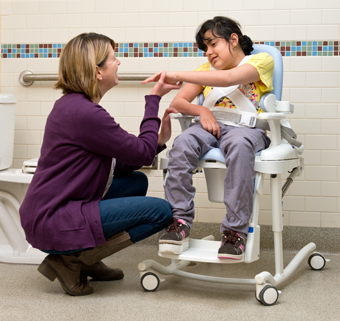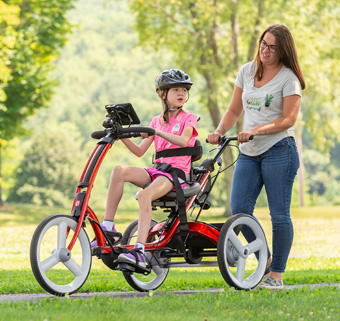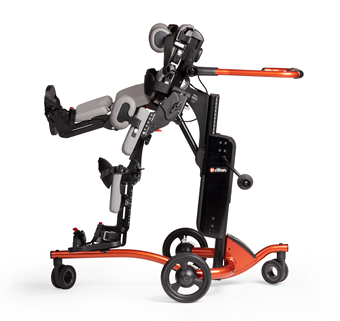Child-focused vs Context-focused Intervention
Should intervention focus on the child or the environment?
| February 2018In a fascinating research project, Law and colleagues set out to test the efficacy of context-focused intervention.¹
 What is the context-focused approach? In this approach, the primary therapist (either an occupational or a physical therapist), works with the parents to identify tasks the child is interested in learning. The therapists assists to identify task and environmental modifications and implements these to enable task practice. The family is then left alone to experiment and provide the child with practice time. The therapist monitors progress and changes strategies that have been ineffective after 2 weeks of trial. In the context-focused approach, the therapist is not allowed to use any remediation strategies.
What is the context-focused approach? In this approach, the primary therapist (either an occupational or a physical therapist), works with the parents to identify tasks the child is interested in learning. The therapists assists to identify task and environmental modifications and implements these to enable task practice. The family is then left alone to experiment and provide the child with practice time. The therapist monitors progress and changes strategies that have been ineffective after 2 weeks of trial. In the context-focused approach, the therapist is not allowed to use any remediation strategies.
To test the context-focused approach against the child-focused approach , 71 subjects were assigned to the child-focused group and 57 to the context-focused group. All children were diagnosed with cerebral palsy and classified across different GMFCS levels, from I to V. The children ranged in age from 12 months to 5 years 11 months.
Subjects received either approach for six months. Over that period, on average the child-focused subjects received 18.7 sessions while the context-focused subjects received 17.7.
The top five strategies used by the therapists applying the child-focused approach were:
1. Practice of upper extremity motor activities
2. Practice of functional mobility activities
3. Training components of movement
4. Practice of stationary gross motor skills
5. Stretching
On the other hand, the top five strategies for therapists applying the context-focused approach were:
1. Modifying physical characteristics of environment, task, materials or tools
2. Practice of functional mobility activities
3. Changing a task instruction
4. Adding adaptive equipment
5. Providing education/instruction to the family
As you can see, the two approaches shared only one common strategy among their top five – the practice of functional mobility activities.
Students were tested prior to the start of the intervention, after the six-month intervention period, and then again at nine months (3 months after the end of the interventions, during which time the subjects returned to their usual intervention). Measures used included: Pediatric Evaluation of Disability Inventory (PEDI), Gross Motor Functional Measure (GMFM), range of motion (ROM) and the Assessment of Preschool Children’s Participation (ACPC).
Findings
Both groups showed significantly improved PEDI, GMFM and ACPC scores after six months of intervention. There were no significant differences in the test performance of both groups.
No further change was noted at the ninth month testing (after the children resumed their regular therapy sessions) except for the PEDI Caregiver Mobility Scale, where a slight increase was recorded in the child-focused group, while a slight decrease was recorded in the context-focused group.
Both groups exhibited maintenance of range of motion for hip extension, popliteal angle and ankle dorsiflexion, and an increase for hip abduction.
Discussion
Hooray! These results suggest that it might actually be the use of therapist cognitive skills (i.e., clinical reasoning, task analysis, problem-solving and other relevant skills) that makes us effective … and therefore, worthy of the title “occupational therapist” or “physical therapist.” Shake off the need to be hands-on all the time. “Brains on” can also be just as effective.
Good news! Because there was generally no decline at the ninth month testing (three months after the interventions were discontinued) we know the children retained the skills they learned – one sign that motor learning occurred.
In another study, Kruijsen-Terpstra, et al compared the context-focused approach vs. the child-focused vs. “regular” therapy. They found that all 3 approaches resulted in “significant but similar improvements in self-care and mobility skills.²”
Let’s think about these results. Here are some interesting lessons from this study:
The context-focused approach is as effective as the child-focused approach.
Though this may be an unexpected result, it makes sense if you look at it from the motor learning perspective. Motor learning can occur by modifying the task and the environment to encourage the child to practice the task repeatedly, using strategies that the child’s body affords.
Passive stretching may not be necessary to maintain range of motion.
Since remediation strategies such as stretching are not allowed under the context-focused approach, the investigators were concerned that range of motion will be lost. Thus, in addition to the pre- and post-tests, ROM was also measured three months into the intervention. The results therefore put into question not just this concern, but also the utility of stretching. It supports the findings of published literature reviews that regular stretching does not produce clinically important changes in joint mobility.3,4 So is it time for therapists to stop stretching? This result may also support the idea that there are other ways to maintain range of motion, such as through active movement when completing functional activities.
GMFM may improve without direct focus on motor skills.
The investigators surmised that “the ability to improve functional skills and practice them more often contributed to the changes in their motor abilities.” Perhaps, this may mean that being prescriptive on how to perform an activity may not be necessary in improving motor skills. We can set up the task and environment to provide frequent opportunities for practice and encourage students to use strategies that their bodies allow.
Families can be involved from assessment to intervention.
We all know that the family can be a great resource in getting to know the child. This study further supports that they can also be our partners in assessment, goal setting, intervention planning and intervention implementation. Partner up with families and empower them to help their children improve! In school-based practice, I would extend this lesson to teachers and other school staff. Like families, they spend the most time with our students. So, similarly, we should partner with them when assessing the student, setting goals, planning interventions and implementing them.
Both groups of therapists have embraced practice of functional mobility activities.
For the sake of the study, the researchers had to be strict. They instructed therapists to either provide remediation alone, or task and environmental modification without remediation. It was great news to hear that despite this limitation, both groups still chose to practice functional mobility activities. If there has been a preponderance in evidence for our practice, it is that an activity-focused approach is essential in learning motor skills.
Final Thoughts
So is one approach better than the other? Two adages come to mind: “everything in moderation, including moderation itself” and “there is a time for everything and everything in its time.”
Each intervention approach has its own merits – a statement which we think is supported by this study. As therapists, we should discern when one is needed more than the other.
However, we may want to recognize that while as therapists we love gravitating towards focusing on the child, we may not take enough advantage of focusing on the context. We should strive to achieve the right proportion of each that is needed depending on the situation.
This lesson is most useful for those of us in school-based practice, where a therapist’s “hands on” time may be limited. We should partner with parents/guardians, teachers and other school staff. Together, we can conduct ecological assessments, create goals and plan interventions, modify the school task and environment, try out strategies to find ones that create success quickly, and encourage practice of the skills in the natural environment.
This post is adapted from this original article on Seek Freaks website:
https://www.seekfreaks.com/index.php/2016/06/16/article-review-child-focused-vs-context-focused-intervention/
References:
1. Law M, Darrah J, Pollock N, Wilson B, Russell, DJ, Walter SD, Rosenbaum P, Galuppi B. Focus on function: a cluster, randomized controlled trial comparing child- versus context-focused intervention for young children with cerebral palsy. Dev Med Child Neurol. 2011; 53(7):621-629 Free Full Text
2. Kruijsen‐Terpstra AJ, Ketelaar, VerschurenO, Gorter JW, Vos RC,Verheijden J, et al. Efficacy of three therapy approaches in preschool children with cerebral palsy: a randomized controlled trial. Dev Med Child Neurol. 2016; 58(7): 758-766. Free Full Text
3. Katalinic OM, Harvey LA, Herbert RD. Effectiveness of stretch for the treatment and prevention of contractures in people with neurological conditions: a systematic review. J Phys Ther. 2011; 91(1):11-24. Free Full Text
4. Harvey LA, Katalinic OM, Herbert RD, Moseley AM, Lannin NA, Schurr K. Stretch for the treatment and prevention of contracture. Cochrane Database of Systematic Reviews. 2017;1. Free Full Text




